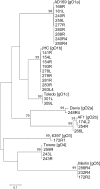Increased Cytomegalovirus Secretion and Risks of Infant Infection by Breastfeeding Duration From Maternal Human Immunodeficiency Virus Positive Compared to Negative Mothers in Sub-Saharan Africa
- PMID: 27103488
- PMCID: PMC5407128
- DOI: 10.1093/jpids/piw015
Increased Cytomegalovirus Secretion and Risks of Infant Infection by Breastfeeding Duration From Maternal Human Immunodeficiency Virus Positive Compared to Negative Mothers in Sub-Saharan Africa
Abstract
Background: Breastfeeding imparts beneficial immune protection and nutrition to infants for healthy growth, but it is also a route for human immunodeficiency virus (HIV) and human cytomegalovirus (HCMV) infection. In previous studies, we showed that HCMV adversely affects infant development in Africa, particularly with maternal HIV exposure. In this study, we analyzed infants risks for acquisition of HCMV infection from breastfeeding and compared HIV-positive and HIV-negative mothers.
Methods: Two cohorts were studied in Zambia. (1) Two hundred sixty-one HIV-infected and HIV-uninfected mothers were compared for HCMV deoxyribonucleic acid (DNA) loads and genotypes (glycoprotein gO) in milk from birth to 4 months postpartum. (2) Maternally HIV-exposed and HIV-unexposed infants were compared for HCMV infection risk factors. The second cohort of 460 infants, from a trial of micronutrient-fortified complementary-food to breastfeeding, were studied between 6 and 18 months of age. Human cytomegalovirus seroprevalence was assayed, and logistic regression was used to calculate risk factors for HCMV infection, including maternal HIV exposure and breastfeeding duration.
Results: Human cytomegalovirus was detected in breast milk from 3 days to 4 months postpartum, with significantly raised levels in HIV-positive women and independent of genotype. In infants, HCMV antibody seroprevalence was 83% by 18 months age. Longer breastfeeding duration increased infection risk in maternally HIV-unexposed (odds ratio [OR] = 2.69 for 18 months vs <12 months; 95% confidence interval [CI], 0.84-8.59; P = .03) and HIV-exposed infants (OR = 20.37 for >6 months vs never; 95% CI, 3.71-111.70; P < .001).
Conclusions: Prolonged breastfeeding, which is common in Africa, increased risk of HCMV infection in infants. Both HIV-positive and HIV-negative women had extended milk HCMV secretion. Women who were HIV-positive secreted higher HCMV levels, and for longer duration, with their children at increased infection risk. Human cytomegalovirus control is required to maintain health benefits of breastfeeding.
Keywords: HCMV; HIV-exposed infants; breast milk; infant HIV; maternal HIV.
© The Author 2016. Published by Oxford University Press on behalf of the Pediatric Infectious Diseases Society.
Figures




Similar articles
-
Human cytomegalovirus infant infection adversely affects growth and development in maternally HIV-exposed and unexposed infants in Zambia.Clin Infect Dis. 2012 Feb 1;54(3):434-42. doi: 10.1093/cid/cir837. Clin Infect Dis. 2012. PMID: 22247303 Free PMC article.
-
High cytomegalovirus load and prolonged virus excretion in breast milk increase risk for viral acquisition by very low birth weight infants.Pediatr Infect Dis J. 2009 Oct;28(10):891-4. doi: 10.1097/INF.0b013e3181a55c52. Pediatr Infect Dis J. 2009. PMID: 19687768
-
Human cytomegalovirus reactivation during lactation and mother-to-child transmission in preterm infants.J Clin Microbiol. 2005 Mar;43(3):1318-24. doi: 10.1128/JCM.43.3.1318-1324.2005. J Clin Microbiol. 2005. PMID: 15750102 Free PMC article.
-
Cytomegalovirus transmission to preterm infants during lactation.J Clin Virol. 2008 Mar;41(3):198-205. doi: 10.1016/j.jcv.2007.12.005. J Clin Virol. 2008. PMID: 18243784 Review.
-
Breast milk-acquired cytomegalovirus infection in very low birth weight infants.J Matern Fetal Neonatal Med. 2012 Oct;25 Suppl 3:57-62. doi: 10.3109/14767058.2012.712345. J Matern Fetal Neonatal Med. 2012. PMID: 23016620 Review.
Cited by
-
Viruses and Human Milk: Transmission or Protection?Adv Nutr. 2023 Nov;14(6):1389-1415. doi: 10.1016/j.advnut.2023.08.007. Epub 2023 Aug 20. Adv Nutr. 2023. PMID: 37604306 Free PMC article. Review.
-
Cytomegalovirus Viremia in HIV-1 Subtype C Positive Women at Delivery in Botswana and Adverse Birth/Infant Health Outcomes.J Acquir Immune Defic Syndr. 2019 May 1;81(1):118-124. doi: 10.1097/QAI.0000000000001982. J Acquir Immune Defic Syndr. 2019. PMID: 30964806 Free PMC article.
-
Human Cytomegalovirus Immune Evasion of Natural Killer Cells: A Virus for All Seasons?Pathogens. 2025 Jun 24;14(7):629. doi: 10.3390/pathogens14070629. Pathogens. 2025. PMID: 40732677 Free PMC article. Review.
-
Complexity of Human Cytomegalovirus Infection in South African HIV-Exposed Infants with Pneumonia.Viruses. 2022 Apr 21;14(5):855. doi: 10.3390/v14050855. Viruses. 2022. PMID: 35632596 Free PMC article.
-
Multiple-Strain Infections of Human Cytomegalovirus With High Genomic Diversity Are Common in Breast Milk From Human Immunodeficiency Virus-Infected Women in Zambia.J Infect Dis. 2019 Jul 31;220(5):792-801. doi: 10.1093/infdis/jiz209. J Infect Dis. 2019. PMID: 31050737 Free PMC article.
References
-
- Boppana SB, Fowler KB. Persistence in the population: epidemiology and transmission. In: Arvin A, Campadelli-Fiume G, Mocarski ES Jr et al.. Human Herpesviruses: Biology, Therapy, and Immunoprophylaxis. Chapter 44. Cambridge: Cambridge University Press, 2007. - PubMed
-
- Capretti MG, Lanari M, Lazzarotto T et al. . Very low birth weight infants born to cytomegalovirus-seropositive mothers fed with their mother's milk: a prospective study. J Pediatr 2009; 154:842–8. - PubMed
-
- Jim WT, Shu CH, Chiu NC et al. . High cytomegalovirus load and prolonged virus excretion in breast milk increase risk for viral acquisition by very low birth weight infants. Pediatr Infect Dis J 2009; 28:891–4. - PubMed
-
- Kurath S, Halwachs-Baumann G, Muller W, Resch B. Transmission of cytomegalovirus via breast milk to the premature born infant: a systematic review. Clin Microbiol Infect 2010; 16:1172–8. - PubMed
MeSH terms
LinkOut - more resources
Full Text Sources
Other Literature Sources
Medical

